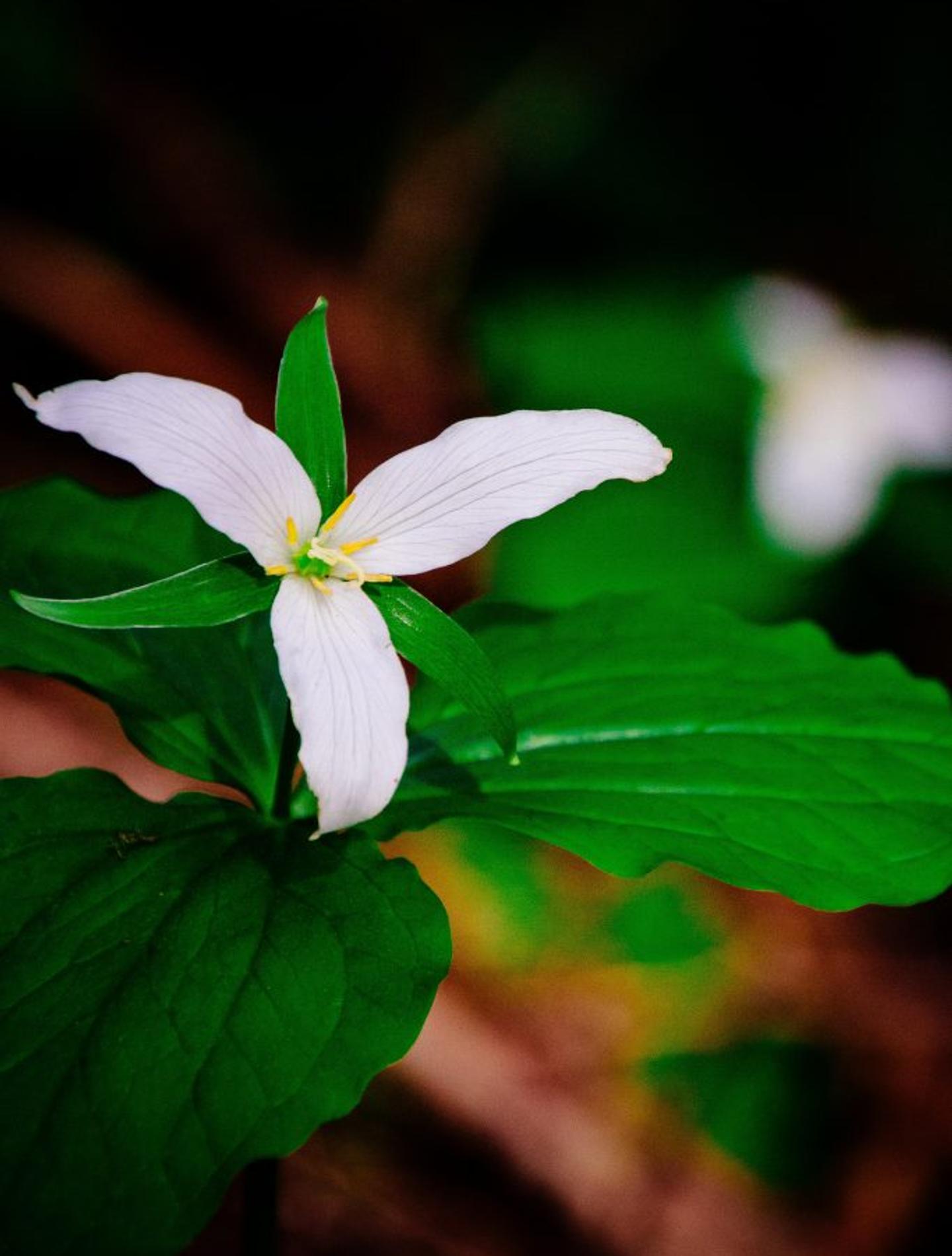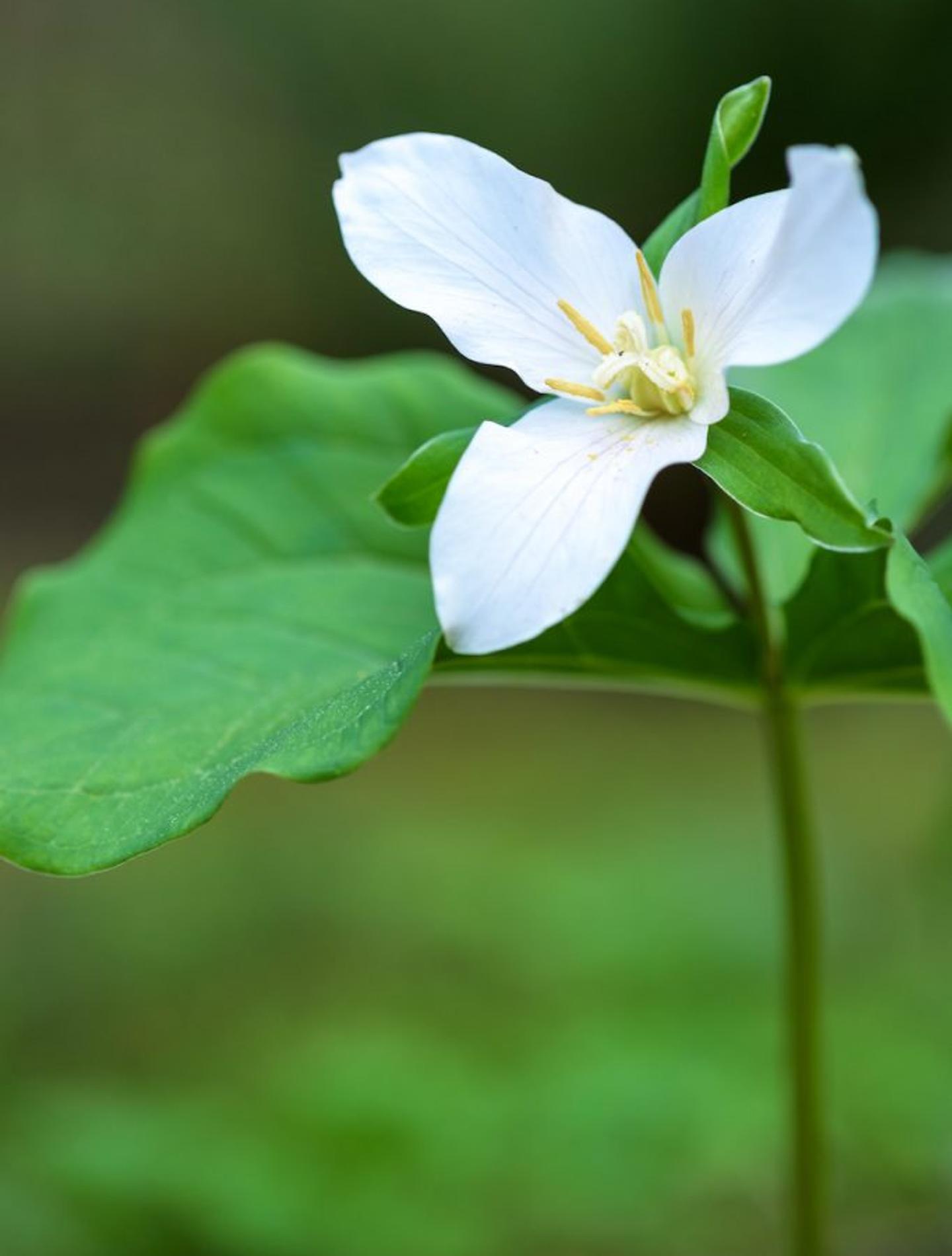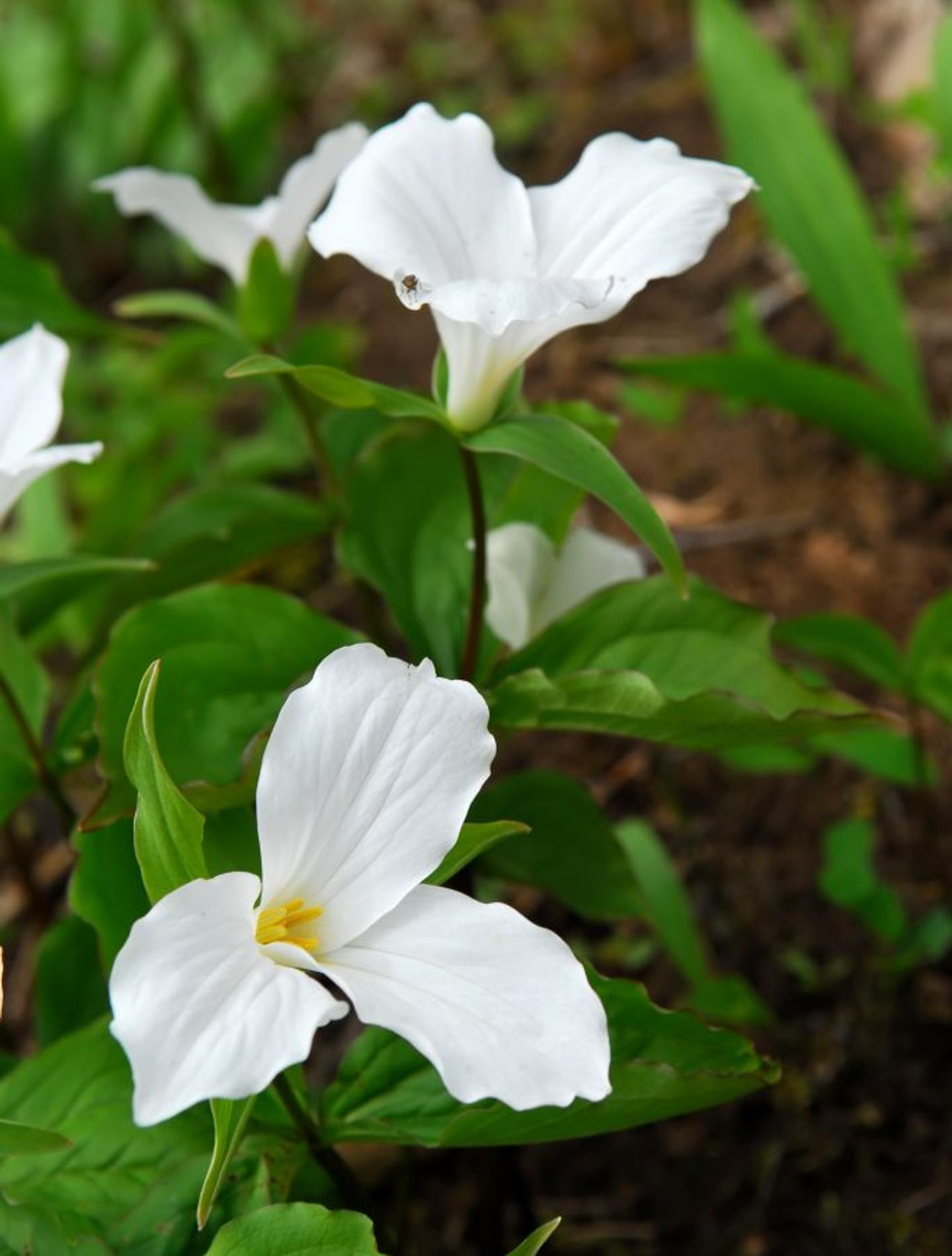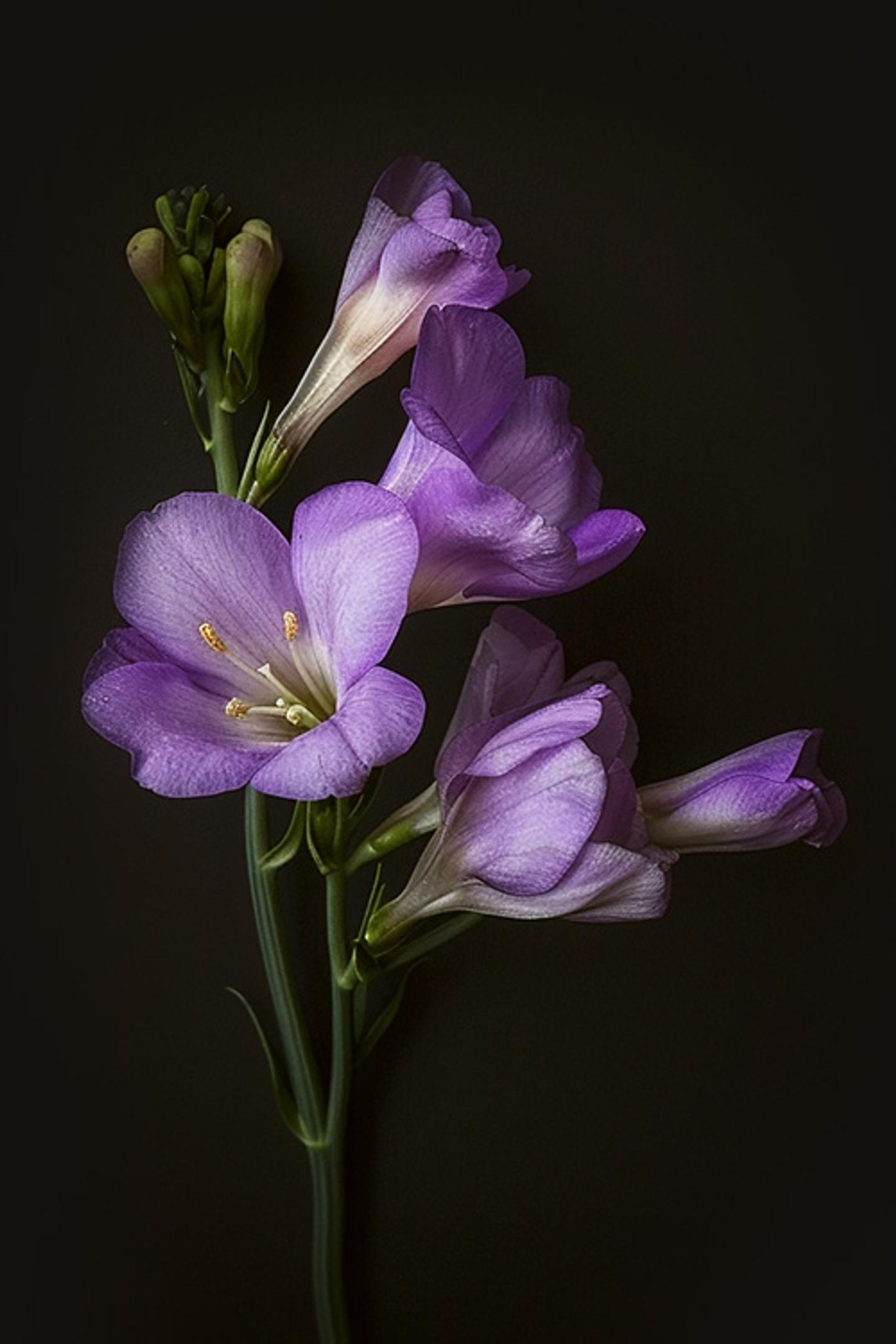Flower Meanings
Great White Trillium


The Meaning of Trilliums
Trillium has been around for quite a while, so it’s no surprise this lovely simplistic bloom has collected quite a bit of symbolism in its time. Trillium’s literal meaning is “three-parted lily,” according to the Armorial Gold Heraldry Symbolism Library. But let’s see what else we can unpack, shall we?
- Christian Trinity: The picking of the Great White Trillium off a mountain is said to bring rain. The flower also often symbolizes purity, beauty, and recovery. [1]
- Releasing & Overcoming Fears: Specifically, when it comes to fears concerning the physical body. The purpose of overcoming this fear is to strengthen our physical connection to the Earth, all while increasing our spiritual understanding. The trillium essentially acts as a bridge between our physical and spiritual bodies, allowing us to become a wholly spiritual being in a physical body. It can also help with relieving feelings of panic.
- Balance: Trillium is also said to represent balance. Ultimately, the goal is to aid us in balancing certain areas of our lives and our bodies in which we feel…well, a bit out of wack. In doing so, we gain the ability to soften where we have become too hard and strengthen where we yield too easily.
- Transformation: All of these effects together lead up to a mental and physical transformation. If we are quiet and reserved, trillium can help us to reach out and connect with others. [2]
Pretty powerful little flower, huh?

"The most showy, best known, and loved of all the trilliums…"
Fred & Roberta Case
The History of the Great White Trillium
Trilliums are native to more temperate regions of North America and Asia and are commonly recognized by their three plush white petals. In fact, the name itself, ‘Trillium’ is actually derived from the bloom itself, as most of it’s pieces come in threes: three leaves, three petals, three blooming characteristics:
- upright
- nodding
- drooping
and three-sectioned seedpods. [3]
These blooms are found in the Himalayas of Asia and spreading from Georgia all the way up through eastern Canada in North America. [1]
Ok, now onto some real history!
There is actually an Ojibwa Legend of the trillium that dates back approximately 400 years. As we know, this delicate white flower can’t be picked without also removing the star-shaped leaves that back its three unusual petals. Therefore, if the flower is picked, it will ultimately result in the death of the flower altogether.
Jumping back about 400 years or so, a Jesuit Father who had recently been sent over to modern-day Canada by the King of France to teach Christianity to the Indians who resided there. Upon his arrival, he learned that there were many more Indians to the West than he had originally believed. In his quest to bring God’s Word to as many non-believers as possible, he decided to venture out and explore this unknown land. In a small Indian-made canoe, he crossed the Ottawa River in what we now know as Ontario.
Unfortunately, he found himself in a bit of a sticky situation: a language barrier that he did not necessarily account for. The Jesuit Father could not understand a word of the language these Western Indians spoke, as it was quite different from the language he had learned from their brothers in the East.
Desperate to find a way to communicate with them, he devoted all of his time and energy to finding a way to do so. During his explorations, he noticed many clusters of unique but beautiful white flowers growing throughout the forests. Each bloom had four petals, all forming the shape of a cross. He knew he had found the perfect way to communicate the Gospel to the Natives. With the help of these tiny little blooms, he was able to tell them all about Christ’s crucifixion. However, the Natives only became depressed by the story and became determined to stay away from this teller of sad tales.
Realizing what had happened, he decided to pluck one of the petals off of the flower, using the remaining three to teach them of The Father, The Son, and The Holy Spirit. He used the small, star-shaped green leaves that support the petals to explain the miracle of Christ’s birth. This time, his teaching went exceptionally well and was deemed quite successful. Proud of what he had achieved, he prayed that some sort of sign would be sent as a reminder to the Native’s of his teachings.
To the Father’s great delight and surprise, when the pretty little flowers bloomed the following year, they only had three petals, standing firm to his depiction of The Trinity. [4]
DID YOU KNOW - Trillium Fun Fact
The Great White Trillium is both the state flower of Ohio and the Provincial flower of Ontario, Canada.

How to Grow Trilliums
Trilliums tend to bloom early and become more dormant by about midsummer, however with suitable growing conditions; they are extremely easy to grow and care for. They also have quite a long garden life to boot!
For trilliums to thrive in your garden, you must do your best to mimic their natural habitat. They LOVE a moist, well-draining soil, enriched with organic matter such as compost (interested in starting your own compost? Click here!). They are best suited for shady spots or wooded gardens. They also made great plant buddies with blooms such as crested iris, jack-in-the-pulpit, hosta, toad lily, and ferns.
Now let’s get to planting!
Since many varieties of trilliums are endangered, it could be a bit difficult to get your hands on some. They also do not transplant well from the wild. Be sure to purchase them from a reputable nursery that specializes in trillium care. You can also propagate them from seed, although flowering will not occur right off the bat. It can take about four to five years to actually see a bloom via propagation.
Collect your seeds in late June – early July when the seed-pod has turned from white to brown. Sow the seeds immediately, or store them in some dampened peat moss and put them in the refrigerator until you’re ready to plant them. Plant your seeds in a shady outdoor seedbed. Make sure your planting spot is enriched with humus or compost and is kept evenly moist throughout the entire growing season.
Be aware that your seeds probably won’t germinate until the second year, so no need for alarm if you don’t see any action right away!
Trilliums can also be propagated by rhizome cuttings with at least 2 inches of soil. Be sure to pace your plants about ten inches apart from one another! [3]
DID YOU KNOW - Trillium Fun Fact
Trillium is also known as birthroot, wake-robin, and Western Lily!

How to Care for Trilliums
Trilliums actually can become severely damaged if they are picked from the ground, as they are incredibly fragile. Essentially, picking these blooms prevents the leaf-like bracts from producing food for the next year, often effectively killing the plant and ensuring none will grow in its place the following year. Yikes…duly noted. [5]
Since trilliums will become seriously injured as soon as you pick them, it is quite impossible to cut them to bring inside for enjoyment safely.
However, once established in your garden, trilliums really don’t require much care or maintenance. As long as they’ve been planted in a suitable location, they’re pretty much good to go. Just be sure to keep the soil evenly moist but not too soggy. If the weather gets dry, they may also require a bit more water.
You shouldn’t need to fertilize your blooms so long as they have plenty of organic material or compost mixed into the soil. [3]
Remember, if you happen to see trillium on a hike, take pictures of them, get a nice close up look, but don’t pick them!
Happy gazing!
When to Send Trillium as a Gift
Since trillium’s tend to symbolize the Christian Trinity, they are the perfect gift to celebrate a First Communion, Baptism, or Confirmation! They also make a great gift for those who may be stuck in a rut and could use a bit of a pick me up from a close friend.

References:
- 1 - ehow.com
- 2 - Spirit of Transformation
- 3 - Gardening Know How
- 4 - First People
- 5 - The Reflector
Flower Meanings — keep discovering

Freesia
The sweet smell of spring! These blooms may be dainty, but don’t let that fool you! We’re talking about freesia!

Gardenia
Gardenias, not to be confused with giardiniera (the pickled vegetable medley), are beloved for their unique fragrance and distinct, creamy-white flowers and leathery green leaves. Gardenias are heat-loving evergreen shrubs or trees that make up for their not-so-easy maintenance with a spellbinding scent.

Gerbera Daisy
They’re sleek; they’re elegant, they’re big, bright, and fabulous. We’re talking about gerbera daisies.

Gladiolus
The gladiolus: a beautiful, proud, tall drink of water. We commonly recognize glads by their strikingly tall stalks and large, abundant blooms that grow in all sorts of vibrant colors. As the month of August’s prized flower, these blooms have a lot more to offer than just their beauty.

Freesia
The sweet smell of spring! These blooms may be dainty, but don’t let that fool you! We’re talking about freesia!

Gardenia
Gardenias, not to be confused with giardiniera (the pickled vegetable medley), are beloved for their unique fragrance and distinct, creamy-white flowers and leathery green leaves. Gardenias are heat-loving evergreen shrubs or trees that make up for their not-so-easy maintenance with a spellbinding scent.

Gerbera Daisy
They’re sleek; they’re elegant, they’re big, bright, and fabulous. We’re talking about gerbera daisies.

Gladiolus
The gladiolus: a beautiful, proud, tall drink of water. We commonly recognize glads by their strikingly tall stalks and large, abundant blooms that grow in all sorts of vibrant colors. As the month of August’s prized flower, these blooms have a lot more to offer than just their beauty.
Ready to send beautiful flowers?
Our guided experience helps you send a one-of-a-kind arrangement perfect for every occasion.
Send Flowers